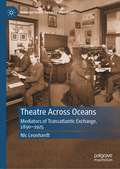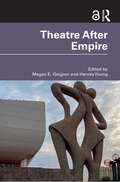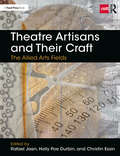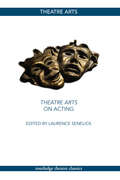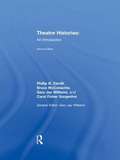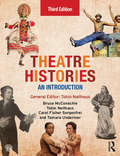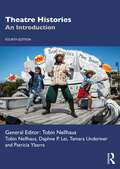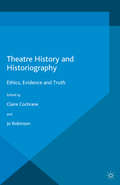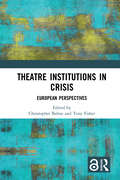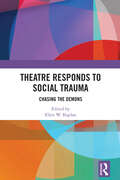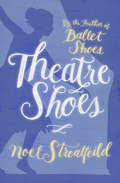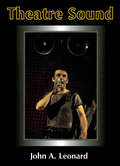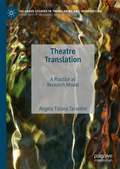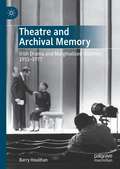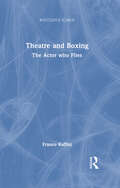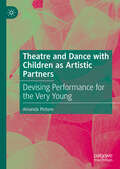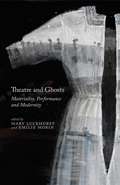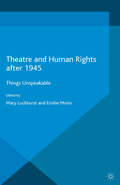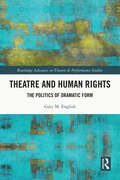- Table View
- List View
Theatre Across Oceans: Mediators of Transatlantic Exchange, 1890–1925 (Transnational Theatre Histories)
by Nic LeonhardtTheatre Across Oceans: Mediators Of Transatlantic Exchange allows the reader to enter and understand the infrastructural 'backstage area' of global cultural mobility during the years between 1890 and 1925. Located within the research fields of global history and theory, the geographical focus of the book is a transatlantic one, based on the active exchange in this phase between North and South America and Europe. Emanating from a rich body of archival material, the study argues that this exchange was essentially facilitated and controlled by professional theatrical mediators (agents, brokers), who have not been sufficiently researched within theatre or historical studies. The low visibility of mediators in the scientific research is in diametrical contrast to the enormous power that they possessed in the period dealt with in this book.
Theatre After Empire
by Harvey Young Megan E. GeignerEmphasizing the resilience of theatre arts in the midst of significant political change, Theatre After Empire spotlights the emergence of new performance styles in the wake of collapsed political systems. Centering on theatrical works from the late nineteenth century to the present, twelve original essays written by prominent theatre scholars showcase the development of new work after social revolutions, independence campaigns, the overthrow of monarchies, and world wars. Global in scope, this book features performances occurring across Africa, the Americas, Asia, Europe, and the Middle East. The essays attend to a range of live events—theatre, dance, and performance art—that stage subaltern experiences and reveal societies in the midst of cultural, political, and geographic transition. This collection is an engaging resource for students and scholars of theatre and performance; world history; and those interested in postcolonialism, multiculturalism, and transnationalism.
Theatre After Empire
by Harvey YoungEmphasizing the resilience of theatre arts in the midst of significant political change, Theatre After Empire spotlights the emergence of new performance styles in the wake of collapsed political systems.Centering on theatrical works from the late nineteenth century to the present, twelve original essays written by prominent theatre scholars showcase the development of new work after social revolutions, independence campaigns, the overthrow of monarchies, and world wars. Global in scope, this book features performances occurring across Africa, the Americas, Asia, Europe, and the Middle East. The essays attend to a range of live events—theatre, dance, and performance art—that stage subaltern experiences and reveal societies in the midst of cultural, political, and geographic transition.This collection is an engaging resource for students and scholars of theatre and performance; world history; and those interested in postcolonialism, multiculturalism, and transnationalism.The Introduction ("Framing Latine Theatre and Performance") of this book is freely available as a downloadable Open Access PDF at http://www.taylorfrancis.com under a Creative Commons [Attribution-Non Commercial-No Derivatives (CC-BY-NC-ND)] 4.0 license.
Theatre Artisans and Their Craft: The Allied Arts Fields (Backstage)
by Rafael JaenTheatre Artisans and Their Craft: The Allied Arts Fields profiles fourteen remarkable artists and technicians who elevate theatre production to new dimensions, explore new materials and technologies, and introduce new safety standards and solutions. Readers will learn how the featured artists delved into entrepreneurial ventures and created their own work for themselves; researching, studying, and experimenting, seeking answers when none were available. The book explores how to make an impact in the entertainment industry from behind the scenes, and how students can model themselves after these successful professionals to jump-start their career in theatre production. Aimed at theatre and film practitioners in the allied arts fields, Theatre Artisans and Their Craft offers a collection of success stories that are both inspiring and informative.
Theatre Arts on Acting
by Laurence SenelickDuring its fifty year run, Theatre Arts Magazine was a bustling forum for the foremost names in the performing arts, including Stanislavski, Laurence Olivier, Lee Strasberg, John Gielgud and Shelley Winters. Renowned theatre historian Laurence Senelick has plundered its stunning archives to assemble a stellar collection of articles on every aspect of acting and theatrical life.
Theatre Buildings: A Design Guide
by Margaret Shewring David HamerIn 2021, its Diamond Jubilee year, the Association of British Theatre Technicians (ABTT) undertook to revise Theatre Buildings: A Design Guide (Routledge, 2010). This new edition (Routledge, 2023) has substantially re-written text with fresh images and entirely new reference projects, providing essential guidance for all those engaged in the design of theatre buildings. Edited by Margaret Shewring (Emeritus Reader, University of Warwick, former Director of the Postgraduate Diploma and MA in Theatre Consultancy), this new publication is written by a team of international experts, architects, theatre consultants, acousticians, engineers and industry professionals led by Tim Foster (Foster Wilson Size) and Robin Townley (CEO of the ABTT). It provides an invaluable resource for those looking to build, remodel or conserve theatre buildings, taking into account the significant changes which have taken place in the last twelve years in all aspects of theatre design and technical practice. It locates those changes in the wider context of the need for sustainability in the theatre industry in response to the climate emergency, inclusivity, diversity of access, placemaking and concerns for health and wellbeing. This new edition provides guidance for anyone who seeks inspiration and encouragement to create or improve a place of entertainment or who seeks to understand what might be required to accommodate an audience for the presentation of live performance and the successful use, operation and organisation of such a venue. Its generous format and the thirty-two new reference projects, more than 260 high-resolution colour images and 175 diagrams and specially commissioned plans make it accessible and informative both to the general reader and the professional specialist.
Theatre Histories
by Phillip B. Zarrilli Carol Fisher Sorgenfrei Gary Jay Williams Bruce McconachieThis new edition of the innovative and widely acclaimed Theatre Histories: An Introduction offers overviews of theatre and drama in many world cultures and periods together with case studies demonstrating the methods and interpretive approaches used by today's theatre historians. Completely revised and renewed in color, enhancements and new material include: a full-color text design with added timelines to each opening section a wealth of new color illustrations to help convey the vitality of performances described new case studies on African, Asian, and Western subjects a new chapter on modernism, and updated and expanded chapters and part introductions fuller definitions of terms and concepts throughout in a new glossary a re-designed support website offering links to new audio-visual resources, expanded bibliographies, approaches to teaching theatre and performance history, discussion questions relating to case studies and an online glossary.
Theatre Histories: An Introduction
by Carol Fisher Sorgenfrei Tamara Underiner Bruce McConachie Tobin NellhausThis thoroughly revised and updated third edition of the innovative and widely acclaimed Theatre Histories: An Introduction offers a critical overview of global theatre and drama, spanning a broad wealth of world cultures and periods. Bringing together a group of scholars from a diverse range of backgrounds to add fresh perspectives on the history of global theatre, the book illustrates historiographical theories with case studies demonstrating various methods and interpretive approaches. Subtly restructured sections place the chapters within new thematic contexts to offer a clear overview of each period, while a revised chapter structure offers accessibility for students and instructors. Further new features and key updates to this third edition include: A dedicated chapter on historiography New, up to date, case studies Enhanced and reworked historical, cultural and political timelines, helping students to place each chapter within the historical context of the section Pronunciation guidance, both in the text and as an online audio guide, to aid the reader in accessing and internalizing unfamiliar terminology A new and updated companion website with further insights, activities and resources to enable students to further their knowledge and understanding of the theatre.
Theatre Histories: An Introduction
by Daphne P. Lei Patricia Ybarra Tamara Underiner Tobin NellhausThis updated fourth edition of Theatre Histories offers a critical overview of global theatre, drama, and performance, spanning a broad wealth of world cultures and periods, integrating them chronologically or thematically, and showing how they have often interacted.Bringing together a group of scholars from a diverse range of backgrounds and approaches to the history of global theater, this introduction to theatre history places theatre into its larger historical contexts and attends to communication’s role in shaping theatre. Its case studies provide deeper knowledge of selected topics in theater and drama, and its “Thinking Through Theatre Histories” boxes discuss important concepts and approaches used in the book.Features of the fully updated fourth edition include: Deeper coverage of East Asian and Latin American theater. Richer treatment of popular culture. More illustrations, photographs, and information about online resources. New case studies, include several written by authoritative scholars on the topic. Pronunciation guidance, both in the text and as audio files online. Timelines. An introduction on historiography. A website with additional case studies, a glossary, recordings of the pronunciation of important non-English terms, and instructor resources. A case studies library listing, including both those in print and online, for greater instructor choice and flexibility. This is an essential textbook for undergraduate courses in theatre history, world theatre and introduction to theatre, and anyone looking for a full and diverse account of the emergence, development, and continuing relevance of theatre to cultures and societies across the world.
Theatre Histories: An Introduction (2nd edition)
by Phillip B. Zarrilli Bruce A. Mcconachie Carol Fisher Sorgenfrei Gary Jay WilliamsThis new edition of the innovative and widely acclaimed Theatre Histories: An Introduction offers overviews of theatre and drama in many world cultures and periods together with case studies demonstrating the methods and interpretive approaches used by today's theatre historians. Completely revised and renewed in color, enhancements and new material include: A full-color text design with added timelines to each opening section A wealth of new color illustrations to help convey the vitality of performances described New case studies on African, Asian, and Western subjects A new chapter on modernism, and updated and expanded chapters and part introductions Fuller definitions of terms and concepts throughout in a new glossary A re-designed support website offering links to new audio-visual resources, expanded bibliographies, approaches to teaching theatre and performance history, discussion questions relating to case studies and an online glossary.
Theatre History and Historiography: Ethics, Evidence and Truth (Methuen Drama Handbooks Ser.)
by Claire CochraneThis collection of essays explores how historians of theatre apply ethical thinking to the attempt to truthfully represent their subject - whether that be the life of a well-known performer, or the little known history of colonial theatre in India - by exploring the process by which such histories are written, and the challenges they raise.
Theatre Institutions in Crisis: European Perspectives
by Christopher Balme; Tony FisherTheatre Institutions in Crisis examines how theatre in Europe is beset by a crisis on an institutional level and the pressing need for robust research into the complex configuration of factors at work that are leading to significant shifts in the way theatre is understood, organised, delivered, and received. Balme and Fisher bring together scholars from different disciplines and countries across Europe to examine what factors can be said to be most common to the institutional crisis of European theatre today. The methods employed are drawn from systems theory, social-scientific approaches, economics and statistics, theatre and performance, and other interpretative approaches (hermeneutics), and labour studies. This book will be of great interest to researchers, students, and practitioners working in the fields of performance and theatre studies. It will be particularly relevant to researchers with a particular interest in European theatre and its networks.
Theatre Responds to Social Trauma: Chasing the Demons (Routledge Series in Equity, Diversity, and Inclusion in Theatre and Performance)
by Ellen W. KaplanThis book is a collection of chapters by playwrights, directors, devisers, scholars, and educators whose praxis involves representing, theorizing, and performing social trauma.Chapters explore how psychic catastrophes and ruptures are often embedded in social systems of oppression and forged in zones of conflict within and across national borders. Through multiple lenses and diverse approaches, the authors examine the connections between collective trauma, social identity, and personal struggle. We look at the generational transmission of trauma, socially induced pathologies, and societal re-inscriptions of trauma, from mass incarceration to war-induced psychoses, from gendered violence through racist practices. Collective trauma may shape, protect, and preserve group identity, promoting a sense of cohesion and meaning, even as it shakes individuals through pain. Engaging with communities under significant stress through artistic practice offers a path towards reconstructing the meaning(s) of social trauma, making sense of the past, understanding the present, and re-visioning the future.The chapters combine theoretical and practical work, exploring the conceptual foundations and the artists’ processes as they interrogate the intersections of personal grief and communal mourning, through drama, poetry, and embodied performance.
Theatre Shoes
by Noel StreatfeildWhen their father is captured during the war, three children come to London to live with their grandmother and join their talented theatrical family in a school for stage training.
Theatre Shoes
by Noel StreatfeildThis captivating companion to Ballet Shoes tells the story of 3 orphans who become students at a famous theatre school After their father disappeared in the war, Sorrell, Holly, and Mark Forbes were sent to live with their grandfather. When he dies, the three orphans are on the move again--this time to London, where their maternal grandmother is a well-known actress. The city is a strange, bustling place that frightens young Holly, but the siblings' new home at 14 Ponsonby Square has a garden that instantly enchants them. Their grandmother enrols them at the Children's Academy of Dancing and Stage Training, where they'll carry on the tradition of their famous theatre family, which includes cousins they never knew they had. Stuck-up Miranda thinks she can act better than Sorrel; homesick Mark discovers he can sing; and Holly is a natural dancer. Will Sorrel, Holly, and Mark live up to their family legacy?
Theatre Shoes (Shoes #3)
by Noel StreatfeildThis captivating companion to Ballet Shoes tells the story of 3 orphans who become students at a famous theatre school After their father disappeared in the war, Sorrell, Holly, and Mark Forbes were sent to live with their grandfather. When he dies, the three orphans are on the move again—this time to London, where their maternal grandmother is a well-known actress. The city is a strange, bustling place that frightens young Holly, but the siblings&’ new home at 14 Ponsonby Square has a garden that instantly enchants them. Their grandmother enrols them at the Children&’s Academy of Dancing and Stage Training, where they&’ll carry on the tradition of their famous theatre family, which includes cousins they never knew they had. Stuck-up Miranda thinks she can act better than Sorrel; homesick Mark discovers he can sing; and Holly is a natural dancer. Will Sorrel, Holly, and Mark live up to their family legacy?
Theatre Sound
by John A. LeonardTheatre Sound includes a brief history of the use of sound in the theatre, discussions of musicals, sound effects, and the recording studio, and even an introduction to the physics and math of sound design. A bibliography and online reference section make this the new essential work for students of theatre and practicing sound designers.
Theatre Translation: A Practice as Research Model (Palgrave Studies in Translating and Interpreting)
by Angela Tiziana TarantiniThis book examines the effects of translation on theatrical performance. The author adapts and applies Kershaw et al.’s Practice as Research model to an empirical investigation analysing the effects of translation on the rhythm and gesture of a playtext in performance, using the contemporary plays Convincing Ground and The Gully by Australian playwright David Mence which have been translated into Italian. The book is divided into two parts: a theoretical exegesis encompassing Translation Studies, Performance Studies and Gesture Studies, and a practical investigation comprising of a workshop where excerpts of the plays are explored by two groups of actors. The chapters are accompanied by short clips of the performance workshop hosted on SpringerLink. The book will be of interest to students and scholars in the fields of Translation Studies (and Theatre Translation more specifically), Theatre and Performance, and Gesture Studies.
Theatre and Archival Memory: Irish Drama and Marginalised Histories 1951-1977
by Barry HoulihanThis book presents new insights into the production and reception of Irish drama, its internationalisation and political influences, within a pivotal period of Irish cultural and social change. From the 1950s onwards, Irish theatre engaged audiences within new theatrical forms at venues from the Pike Theatre, the Project Arts Centre, and the Gate Theatre, as well as at Ireland’s national theatre, the Abbey. Drawing on newly released and digitised archival records, this book argues for an inclusive historiography reflective of the formative impacts upon modern Irish theatre as recorded within marginalised performance histories. This study examines these works' experimental dramaturgical impacts in terms of production, reception, and archival legacies. The book, framed by the device of ‘archival memory’, serves as a means for scholars and theatre-makers to inter-contextualise existing historiography and to challenge canon formation. It also presents a new social history of Irish theatre told from the fringes of history and reanimated through archival memory.
Theatre and Boxing: The Actor who Flies (Routledge Icarus)
by Franco RuffiniTheatre and Boxing focuses on a problem which is of paramount importance for any theatre practitioner and researcher: the actor’s believable body. This problem has been taken up by Stanislavski, Meyerhold, Artaud, Brecht, Decroux, Copeau, Grotowski, and many others. It is an essential hurdle for all who practice the theatrical craft or want to study it theoretically. This hurdle can be considered one of the foundations of theatre science and of the relationship between technique, politics and ethics. This book tells the story of a revolution in the work of the actor in the early- and mid-20th century, a period in which the focus of theatrical interest shifted from the emotions to the body. The actor’s body became a tool for purveying a dynamic set of actions which often transformed the very actor himself. This new centrality of the body also drew attention to those places in which the body is central: the gym, the boxing ring and the circus with its trapezes and tightropes became, together with the stage, laboratories for the theatre. Thus, in addition to the reformers of the theatre the pages of this book are filled with boxers, acrobats, gymnasts and wrestlers, pursuers of an utopia: the "actor who flies".
Theatre and Dance with Children as Artistic Partners: Devising Performance for the Very Young
by Amanda PintoreThis book offers a methodological framework for developing research-based Theatre and Dance for the Very Young (TDVY) performances in which artists collaborate with children ages 0-6 and their caregivers and/or educators as creative partners in the process. It provides a detailed investigation of all stages of the work including: designing and executing a creative research plan, analyzing tools for assessment, using research results as the foundation of a devising process, and outcomes for final performances for this age range. This process reflects on years of creative research with very young children, the results of which include methods for building collaborative performances with a variety of institutions such as early childhood centers, universities, community spaces, and non-profit arts organizations. The main themes addressed in this book are innovative methods for devising and collaboration, the translation of research into performance, and the integral bonds between early childhood development and artistic experiences.
Theatre and Everyday Life: An Ethics of Performance
by Alan ReadAlan Read asserts that there is no split between the practice and theory of theatre, but a divide between the written and the unwritten. In this revealing book, he sets out to retrieve the theatre of spontaneity and tactics, which grows out of the experience of everyday life. It is a theatre which defines itself in terms of people and places rather than the idealised empty space of avant garde performance. Read examines the relationship between an ethics of performance, a politics of place and a poetics of the urban environment. His book is a persuasive demand for a critical theory of theatre which is as mentally supple as theatre is physically versatile.
Theatre and Ghosts: Materiality, Performance and Modernity
by M. Luckhurst E. MorinTheatre and Ghosts brings theatre and performance history into dialogue with the flourishing field of spectrality studies. Essays examine the histories and economies of the material operations of theatre, and the spectrality of performance and performer.
Theatre and Human Rights after 1945: Things Unspeakable
by Mary Luckhurst Emilie MorinThis volume investigates the rise of human rights discourses manifested in the global spectrum of theatre and performance since 1945. Essays address topics such as disability, discrimination indigenous rights, torture, gender violence, genocide and elder abuse.
Theatre and Human Rights: The Politics of Dramatic Form (ISSN)
by Gary M. EnglishThis book develops theoretical intersections between theatre and human rights and provides methodologies to investigate human rights questions from within the perspective of theatre as a complex set of disciplines.While human rights research and programming often employ the arts as representations of human rights-related violations and abuses, this study focuses on dramatic form and structure, in addition to content, as uniquely positioned to interrogate important questions in human rights theory and practice. This project positions theatre as a method of examination in addition to the important purposes the arts serve to raise consciousness that accompany other, often considered more primary modes of analysis. A main feature of this approach includes emphasis on dialectical structures in drama and human rights and integration of applied theatre and critical ethnography with more traditional theatre. This integration will demonstrate how theatre and human rights operates beyond the arts as representation model, offering a primary means of analysis, activism, and political discourse.This book will be of great interest to theatre and human rights practitioners and activists, scholars, and students.
